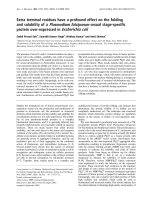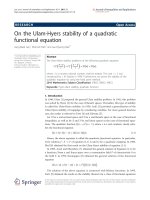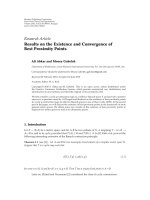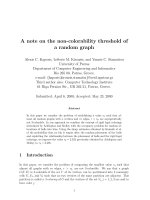Preliminary Results on the Whole Genome Analysis of a Vietnamese Individual
Bạn đang xem bản rút gọn của tài liệu. Xem và tải ngay bản đầy đủ của tài liệu tại đây (71.17 KB, 5 trang )
VNU Journal of Science: Comp. Science & Com. Eng., Vol. 30, No. 3 (2014) 31-35
Preliminary Results on the Whole Genome Analysis
of a Vietnamese Individual
Dang Thanh Hai
1
, Nguyen Dai Thanh
1
, Pham Thi Minh Trang
1
, Dang Cao Cuong
1
,
Hoang Kim Phuc
1
, Son Bao Pham
1
, Le Sy Vinh
1,*
, Le Si Quang
2
, Phan Thi Thu Hang
2
,
Do Duc Dong
3
, Nguyen Huu Duc
4
1
University of Engineering and Technology, Vietnam National University Hanoi
2
Wellcome Trust Center for Human Genetics, Oxford University, UK
3
Institute of Information Technology, Vietnam National University Hanoi
4
High Performance Computing Center, Hanoi University of Science and Technology
Abstract
We present preliminary results on the whole genome analysis of an anonymous Vietnamese individual of the Kinh
ethnic group (KHV) that was deeply sequenced to 30-fold using the Illumina sequencing machines. The sequenced
genome covered 99.8% of the human reference genome (GRCh37). We discovered (1) 3.4 million single
polymorphism nucleotides (SNPs) of which 41,396 (1.2%) were novel, (2) 654 thousand short indels of which
35,263 (5.4%) were novel (i.e., not present in the dbSNP and the 1000 genomes project databases). We also
detected 10,611 large structural variants (length ≥ 100 bp). This study is our initial step toward large-scale genome
projects on Vietnamese population.
© 2014 Published by VNU Journal of Science.
Manuscript communication: Received 18 February 2014, revised 25 March 2014, accepted 27 March 2014
Corresponding author: Le Sy Vinh,
Keywords: High coverage whole genome sequencing, Variant analysis, Vietnamese human genome.
e
1. Introduction
The emerging advances of the next
generation sequencing (NGS) technologies today
have allowed the conduction of a variety of large-
scale sequencing projects, such as the 1000
genomes project [1, 2, 3], the 750 Netherlands
genomes [4] or the 100 southeast Asian Malays
genomes [5]. In addition, due to the low
sequencing cost, a number of studies were
provoked to sequence individuals at high
coverage levels from diverge populations such as
Han Chinese [6], Indian [7], Korean [8], Japanese
[9], Pakistani [10], Turkish [11] and Russian
[12].
Those sequencing efforts for Han Chinese,
Japanese, Korean, Malaysian, Pakistani and
Indian detected millions of genetic variants, of
which an appreciable fraction was population
specific i.e., not present in the dpSNP [13] or the
1000 genomes project (1KGP) database. Vietnam
with approximate 90 million people of 54
different ethnic groups is the 14
th
largest country
by population in the world. Vietnam plays as an
important place in human-being migration
routines over thousands of years of history. The
1KGP was extended to sequence genomes of 100
D.T. Hai et al. / VNU Journal of Science: Comp. Science & Com. Eng., Vol. 30, No. 3 (2014) 31-35
32
Kinh Vietnamese at a low-coverage (4x).
However, such low-coverage sequencing data
generated by the 1000 genomes project might be
biased toward the discovery of high frequency or
common variants. These facts created the
impetus for our comprehensive genome-wide
study of a Kinh Vietnamese (KHV) individual
whose genome was sequenced at a high coverage
level (~30x) by the Illumina HiSeq 2000
machine.
We detected an appreciably large number of
KHV specific genetic variations (including SNPs,
short indels, and structural variations). It
indicated the necessity to conduct further large-
scale genome-wide studies on not only Kinh
group but also other Vietnamese ethic groups to
provide a better and more complete picture of
Vietnamese human genome variations.
2. Materials and methods
2.1. Data production
The genome of an anonymous male Kinh
Vietnamese individual without any obvious
genetic disorders was deeply sequenced at 30-
fold average coverage by Illumina HiSeq 2000
machine (Illumina Inc.,) at the BGI-Hongkong
using two paired-end libraries with the insert size
of 500 base pairs and the read length of 100 base
pairs. The donor is of the Kinh Vietnamese ethnic
group for at least 3 generations. The donor gave
written consent for public release of the genomic
data for scientific research use.
2.2. Methods
BWA [14] was used to map short reads into
the reference genome (GRCh37). To identify
SNPs and short indels, we used GATK toolkit
from the Boad Institute [15, 16], and followed the
recommended best practice workflow.
We compared the detected variants with the
dbSNP (Build 138, [13]) and the 1000 genomes
project database. The Breakdancer tool (version
1.4.4, [17]) was used with default parameters for
calling structural variants from high quality
(Phred-score mapping quality ≥ 20) mapped
paired-end reads. The DGV database of human
genomic structural variations (version released on
2013-07-23, [18]) was used to assess the novelty
of these predicted structural variants.
3. Results
We obtained 578 million paired-end reads of
100 base pair length of which 98% reads had the
quality greater than or equal to 20 (see Figure 1).
Most of the reads (99.99%) were mapped to the
reference genome and 99.8% of the reference
genome (excluding undetermined nucleotides Ns)
was covered by at least one read. The mapping
quality was high, i.e., 93.8% of reads had the
mapping quality score greater than or equal to 20.
In total, the average coverage of short reads
sequenced from the KHV genome against the
reference genome is about 30x and similar for all
chromosomes.
Figure 1. The quality of short reads.
3.1. SNP calling
We identified 3.4 million SNPs (quality score
>= 20; depth coverage >= 4, filter = PASS). This
number is similar to those reported in other
previous genome-wide studies such as 3.1 million
SNPs in the first Japanese individual genome [9]
and 3.4 millions SNPs in the first Korean genome
[8]. There were 41,396 (1.2%) SNPs that were
not present in the dbSNP database version 138
D.T. Hai et al. / VNU Journal of Science: Comp. Science & Com. Eng., Vol. 30, No. 3 (2014) 31-35
33
(the most comprehensive catalogue of known
SNPs from other large-scale genome-wide studies
[13]). These were considered as KHV specific
SNPs. The number of KHV novel SNPs is
smaller than those detected in Ahn et al. (2009)
[8] and Fujimoto et al. (2010) [9] because we
compared against the latest version (138) of the
dbSNP database. 295 of such novel SNPS were
located in the coding exon regions of which 98
SNPs are synonymous and 197 are non-
synonymous substitutions.
3.2. Indel calling
We identified 654,024 short indels of which
316,802 were insertions while 337,222 were
deletions. These numbers are comparable with
those detected in the Turkish individual genome
[11] and in the Shigemizu genome-wide study
[19]. The lengths of these discovered indels were
mainly from 1 to 6 (Fig. 2). The number of indels
with the length of 1 base pair was 322,544 (54%).
The longest insertion and deletion were of 160
bps and 255 bps, respectively. 291,822 (44.6%)
of the detected indels were located within gene
regions of which 287,678 (98.58%) were found in
introns and 3,062 (1.05%) were in coding exons.
Figure 2. The length of indels detected
in the KHV genome.
3.3. Structural variant calling
Mapped short reads with an average mapping
quality greater than or equal to 20 were used for
structural variant calling. As a result, 10,611
large SVs (length ≥ 100 bp) were identified. This
number was similar to those in other previous
individual genome-wide studies [6, 7, 10]. 9,617
(90.6%) out of these large SVs were large indels.
The remaining of these large SVs included 331
(3.1%) inter-chromosomal translocations (CTX),
357 (3.4%) inversions (INV) and 306 (2.9%)
intra-chromosomal translocations (ITX). Almost
all of such large SVs in the KHV genome have
the length in between 100 to 500 bps (see Fig. 3).
We compared 9277 large indels (5167
insertions and 4110 deletions) occurring on the
same chromosome against the latest version
(2013-07-23) of the Database of Genomic
Variants ( We
found that 1925 insertions and 3978 deletions
were present in the DGV database. The
remaining 3374 large indels were considered as
KHV novel large indels. These novel large indels
included 3242 insertions and 132 deletions.
Figure 3. The length of structural variations detected
in the KHV genome.
D.T. Hai et al. / VNU Journal of Science: Comp. Science & Com. Eng., Vol. 30, No. 3 (2014) 31-35
34
3.4. Conclusion
We have presented the whole genome-wide
study of a Vietnamese individual sequenced at a
high coverage level (30x). The obtained short
reads were of high quality and covered up to
99.8% of the NCBI reference human genome. A
substantial number of novel variants including SNPs,
indels and large structural variants were detected
specific for the Vietnamese individual. These
potentially novel findings were demonstrated to
associate with known gene functional regions,
especially coding-exon regions.
There were 0.01% short reads that were not
mapped to the reference genome. These
unmapped reads could probably be a valuable
genetic source on which we carry out further
studies to discover more KHV-specific genetic
variants. The study could therefore play an
important reference for further large-scale
genome-wide studies on Vietnamese population,
and hence the development of personalized
medicine for Vietnamese people in the near
future. It is no doubt that our preliminary results
presented here can be refined with the Mendelian
law when we have genomes sequenced from a
trio (parent, mother and child).
Acknowledgment
We would like to express our special thanks to
Prof. Nguyen Huu Duc from Vietnam National
University, Hanoi for his continuous
encouragements and supports. We thank prof. Jean
Daniel Zucker, Dr. Zamin Iqbal and prof. Arndt von
Haeseler for their comments on our manuscript.
This work was partly financially supported by the
Science and Technology Foundation of Vietnam
National University, Hanoi.
References
[1]
N. Siva, (2008). 1000 Genomes project. Nature
biotechnology, 26(3), 256-256.
[2]
1000 Genomes Project Consortium. (2010). A map
of human genome variation from population-scale
sequencing. Nature, 467(7319), 1061-1073.
[3]
1000 Genomes Project Consortium. (2012). An
integrated map of genetic variation from 1,092
human genomes. Nature, 491(7422), 56-65.
[4]
D. I. Boomsma, C. Wijmenga, E. P. Slagboom, M.
A. Swertz, L. C. Karssen, A. Abdellaoui, & P. I. de
Bakker (2013). The Genome of the Netherlands:
design, and project goals. European Journal of
Human Genetics.
[5]
L. P. Wong, R. T. H. Ong, W. T. Poh, X. Liu, P.
Chen, R. Li, & Y. Y. Teo (2013). Deep Whole-
Genome Sequencing of 100 Southeast Asian
Malays. The American Journal of Human Genetics.
[6]
J. Wang, W. Wang, R. Li, Y. Li, G. Tian, L.
Goodman, & J. Ye (2008). The diploid genome
sequence of an Asian individual. Nature, 456(7218),
60-65.
[7]
B. J. Hardy, B. Séguin, P. A. Singer, M. Mukerji, S.
K. Brahmachari & A. S. Daar (2008). From diversity
to delivery: the case of the Indian Genome Variation
initiative. Nature Reviews Genetics, 9, S9-S14.
[8]
S.M. Ahn, T.H. Kim, S. Lee, D. Kim, H. Ghang,
D.S. Kim, B.C. Kim, S.Y. Kim, W.Y. Kim, C. Kim,
et al. The first Korean genome sequence and
analysis: full genome sequencing for a socio-ethnic
group. Genome Res. 2009;19:1622-1629.
[9]
A. Fujimoto, H. Nakagawa, N. Hosono, K. Nakano,
T. Abe, K. A. Boroevich, M. Nagasaki, R.
Yamaguchi, T. Shibuya, M. Kubo, et al. Whole-
genome sequencing and comprehensive variant
analysis of a Japanese individual using massively
parallel sequencing. Nat. Genet. 2010;42:931-936.
[10]
M. K. Azim, C. Yang, Z. Yan, M. I. Choudhary, A.
Khan, X. Sun, & Y. Zhang (2013). Complete
genome sequencing and variant analysis of a
Pakistani individual. Journal of human genetics,
58(9), 622-626.
[11]
H. Dogan, H. Can and H. H. Otu (2014). Whole
Genome Sequence of a Turkish Individual. PloS
one, 9(1), e85233.
[12]
K. G. Skryabin, E. B. Prokhortchouk, A. M. Mazur,
E. S. Boulygina, S. V. Tsygankova, A. V.
Nedoluzhko, & M. V. Kovalchuk (2009).
Combining two technologies for full genome
sequencing of human. Acta naturae, 1(3), 102.
[13]
S. T. Sherry, M. H. Ward, M. K. holodov, J. Baker,
L. Phan, E. M. Smigielski, & K. Sirotkin (2001).
dbSNP: the NCBI database of genetic variation.
Nucleic acids research, 29(1), 308-311.
[14]
H. Li and R. Durbin (2009) Fast and accurate short
read alignment with Burrows-Wheeler Transform.
Bioinformatics, 25:1754-60.
[15]
A. McKenna, M. Hanna, E. Banks, A. Sivachenko,
K. Cibulskis, A. Kernytsky, K. Garimella, D.
Altshuler, S. Gabriel, M. Daly, M.A. DePristo
(2010). The Genome Analysis Toolkit: a
MapReduce framework for analyzing next-
generation DNA sequencing data. Genome Res.
20:1297-303.
D.T. Hai et al. / VNU Journal of Science: Comp. Science & Com. Eng., Vol. 30, No. 3 (2014) 31-35
35
[16]
M. DePristo, E. Banks, R. Poplin, K. Garimella, J.
Maguire, C. Hartl, A. Philippakis, G. del Angel, M.A.
Rivas, M. Hanna, A. McKenna, T. Fennell, A.
Kernytsky, A. Sivachenko, K. Cibulskis, S. Gabriel, D.
Altshuler and M. Daly (2011). A framework for
variation discovery and genotyping using next-
generation DNA sequencing data. Nature Genetics.
43:491-498.
[17]
K. Chen, J. W. Wallis, M. D. McLellan, D. E.
Larson, J. M. Kalicki, C. S. Pohl, S. D. McGrath et
al. (2009). BreakDancer: an algorithm for high-
resolution mapping of genomic structural variation.
Nature methods 6, no. 9 (2009): 677-681.
[18]
J. R. MacDonald, R. Ziman, R. K. Yuen, L. Feuk, S.
W. Scherer (2013). The database of genomic
variants: a curated collection of structural variation
in the human genome. Nucleic Acids Res. 2013 Oct
29. PubMed PMID: 24174537
.
[19]
D. Shigemizu, A. Fujimoto, S. Akiyama, T. Abe, K.
Nakano, K. A. Boroevich, & T. Tsunoda (2013).
A practical method to detect SNVs and indels from
whole genome and exome sequencing data.
Scientific reports, 3.
F









